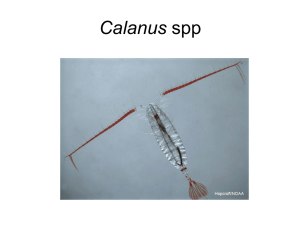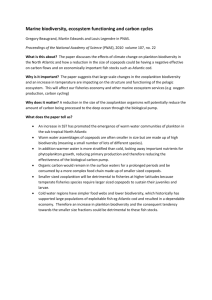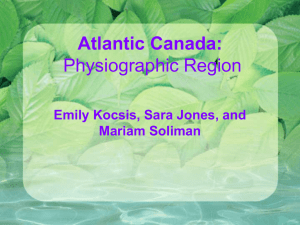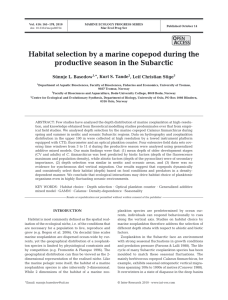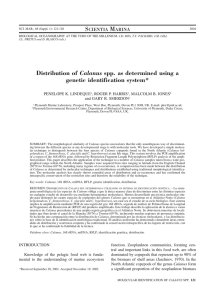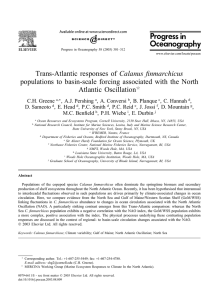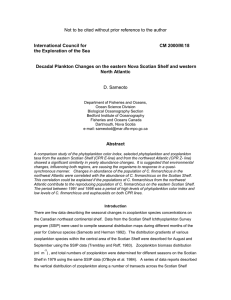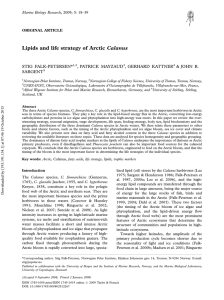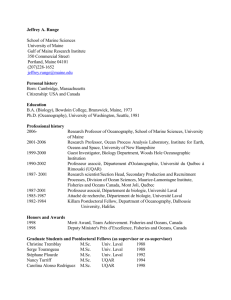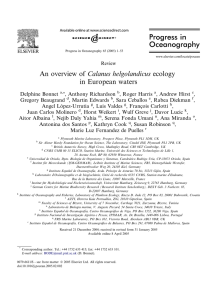North Atlantic Basin Scale Modelling Activities
advertisement
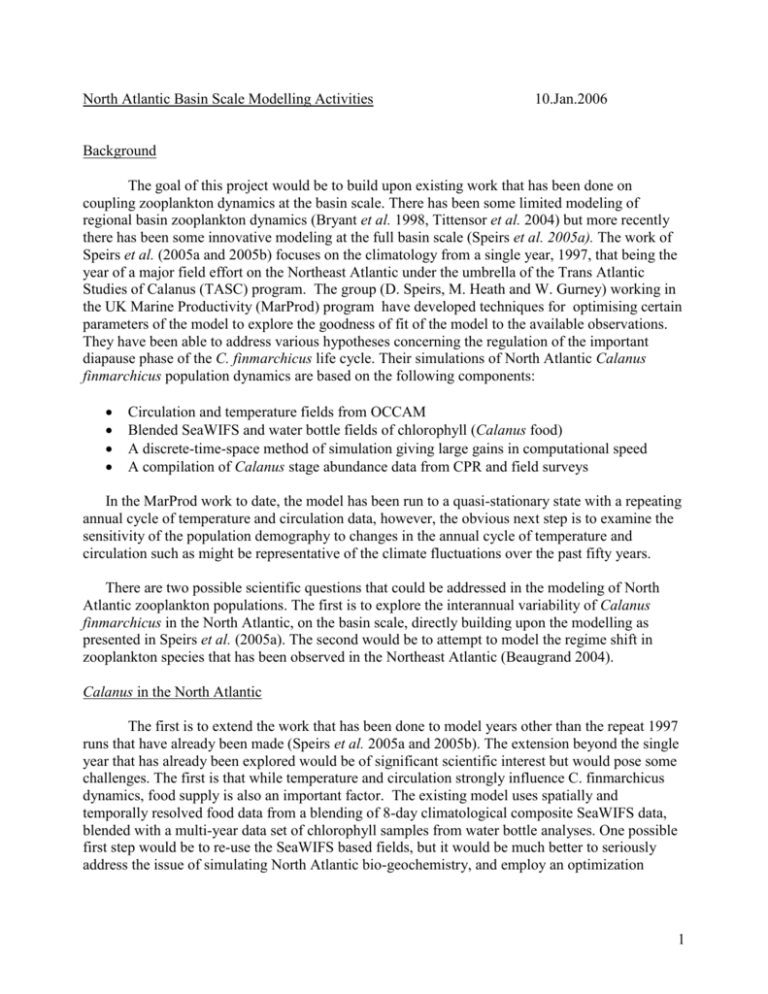
North Atlantic Basin Scale Modelling Activities 10.Jan.2006 Background The goal of this project would be to build upon existing work that has been done on coupling zooplankton dynamics at the basin scale. There has been some limited modeling of regional basin zooplankton dynamics (Bryant et al. 1998, Tittensor et al. 2004) but more recently there has been some innovative modeling at the full basin scale (Speirs et al. 2005a). The work of Speirs et al. (2005a and 2005b) focuses on the climatology from a single year, 1997, that being the year of a major field effort on the Northeast Atlantic under the umbrella of the Trans Atlantic Studies of Calanus (TASC) program. The group (D. Speirs, M. Heath and W. Gurney) working in the UK Marine Productivity (MarProd) program have developed techniques for optimising certain parameters of the model to explore the goodness of fit of the model to the available observations. They have been able to address various hypotheses concerning the regulation of the important diapause phase of the C. finmarchicus life cycle. Their simulations of North Atlantic Calanus finmarchicus population dynamics are based on the following components: Circulation and temperature fields from OCCAM Blended SeaWIFS and water bottle fields of chlorophyll (Calanus food) A discrete-time-space method of simulation giving large gains in computational speed A compilation of Calanus stage abundance data from CPR and field surveys In the MarProd work to date, the model has been run to a quasi-stationary state with a repeating annual cycle of temperature and circulation data, however, the obvious next step is to examine the sensitivity of the population demography to changes in the annual cycle of temperature and circulation such as might be representative of the climate fluctuations over the past fifty years. There are two possible scientific questions that could be addressed in the modeling of North Atlantic zooplankton populations. The first is to explore the interannual variability of Calanus finmarchicus in the North Atlantic, on the basin scale, directly building upon the modelling as presented in Speirs et al. (2005a). The second would be to attempt to model the regime shift in zooplankton species that has been observed in the Northeast Atlantic (Beaugrand 2004). Calanus in the North Atlantic The first is to extend the work that has been done to model years other than the repeat 1997 runs that have already been made (Speirs et al. 2005a and 2005b). The extension beyond the single year that has already been explored would be of significant scientific interest but would pose some challenges. The first is that while temperature and circulation strongly influence C. finmarchicus dynamics, food supply is also an important factor. The existing model uses spatially and temporally resolved food data from a blending of 8-day climatological composite SeaWIFS data, blended with a multi-year data set of chlorophyll samples from water bottle analyses. One possible first step would be to re-use the SeaWIFS based fields, but it would be much better to seriously address the issue of simulating North Atlantic bio-geochemistry, and employ an optimization 1 scheme to fit such a simulation to the available observations so as to constrain it to something close to reality. Northeast Atlantic Zooplankton Regime Shift Perhaps the best documented change in the zooplankton of the Northeast Atlantic is the northerly retreat of C. finmarchicus and the advance of C. helgolandicus latitudinal distributions (Beaugrand 2004). In response to the warming of the north-east Atlantic after the end of the 1970s, substantial biogeographical shifts in calanoid copepods have been detected in the Northeast Atlantic. Warm-water species have moved northwards with concomitant reduction in colder-water species Beaugrand (2005). A link between these large-scale biogeographical shifts and the dynamic regime of North Sea plankton ecosystems have been suggested (Beaugrand and Ibanez 2004) in addition to the more direct hydro-climatic influence of the North Atlantic Oscillation (Reid et al. 2003, Weijerman et al. 2005). The warming of sea temperature in that region has involved a northwards movement of the boundary between the Atlantic Polar and the Atlantic Westerly Winds biome, as defined by Longhurst (1998). As the boundary between the two biomes was located in the North Sea in the central part, a movement of this boundary northwards could explain the abrupt biological changes detected in the North Sea. Evidence for a biogeographical shift in this boundary has been found by looking at zooplankton data. Possible hypotheses for this shift have not yet been quantitatively tested. A full modelling assessment of the finmarchicus/helgolandicus shift in distribution would require a similar approach to that described above for C. finmarchicus to be implemented for C. helgolandicus. New analyses of laboratory data on C. helgolandicus have revealed quite different food and temperature responses of stage development rates for the two species, so it might be possible to envisage a simpler approach by looking at the temperature and circulation forcing alone, initially neglecting food supply. Thus one could take model output for the past few decades to drive production Figure 1 Thermal profiles of Calanus finmarchicus (left) and Calanus helgolandicus (right) at the seasonal scale (development rate) of the two species. (upper panels) and at the annual scale (lower panels). The One could start with a fixed annual cycle profiles were calculated using data from the Continuous of food supply and then, if possible, add Plankton recorder (CPR) and COADS temperature. The the influence of interannual changes in thermal profile shows a clear separation (and food supply, thus allowing some complementarity) of the thermal preferences of both separation of the influence of food supply calanoid copepod species. and temperature. This shift is both a basin-edge and shelf-sea phenomena and so the limited skill of the global coupled model on the shelf will be a serious limitation. 2 An interesting alternative approach, which we could operate in tandem to allow comparison with other data, would be to characterize the ecological niche of both species using both in situ and experimental data on the distribution of zooplankton and environmental conditions. This would allow us to see how their abundance and spatial distribution varies with changing environmental conditions (see Figure 1 for example). This allows us to explore the observed environmental relationship for direct comparison with the forward modeling approach. Comparing this data analysis (see Figure 1) and the modeling approach would enable an analysis of the strengths and limitations of each approach. Approach The development of these pilot projects would require planning to carefully frame the questions to be addressed and to determine the model structures required to answer the questions posed. The key model element in each case is the food supply model. There are ongoing research programs seeking to address this question and it may be possible to include others to assist in filling this particular gap. There are several possible investigators who could be interested in this project: Bill Gurney – University of Strathclyde Doug Speirs – University of Strathclyde Mike Heath - FRS Marine Laboratory Aberdeen Brad deYoung – Memorial University Gregory Beaugrand - CNRS - Université des Sciences et Technologies de Lille Francisco Werner – University of North Carolina Jim Harrell – NCAR Dale Haidvogel – Rutgers University References: Beaugrand, G. 2004. The North Sea regime shift: evidence, causes, mechanisms and consequences. Progress in Oceanography. 60: 245-262. Beaugrand, G. 2005. Monitoring pelagic ecosystems from plankton indicators. - ICES Journal of Marine Science 62: 333-338. Beaugrand G, Ibanez F (2004) Monitoring marine plankton ecosystems (2): long-term changes in North Sea calanoid copepods in relation to hydro-meteorological variability. Marine Ecology Progress Series 284: 35-47 Heath, M.R. et al. 2004. Comparative ecology of over-wintering Calanus finmarchicus in the northern North Atlantic, and implications for life-cycle patterns. ICES Journal of Marine Science, 61: 698-708. Longhurst A (1998) Ecological geography of the Sea. Academic Press, London 3 Reid, P. C., Edwards, M., Beaugrand, G., Skogen, M. and Stevens, D. 2003. Periodic changes in the zooplankton of the North Sea during the twentieth century linked to oceanic inflow. - Fisheries Oceanography 12: 260-269 Speirs, D. et al. 2005a Ocean-scale modeling of the distribution, abundance, and seasonal dynamics of the copepod Calanus finmarchicus. Marine Ecology Progress Series. Speirs, D. et al. 2005b Modelling the basin-scale demography of Calanus finmarchius in the northeast Atlantic. Fisheries Oceanography 14: 333-358. Tittensor, D.P., B. deYoung and C.L. Tang. 2003. Modelling the distribution, sustainability and diapause emergence timing of the copepod. Calanus finmarchicus in the Labrador Sea. Fisheries Oceanography 12: 299-316 Weijerman, M., Lindeboom, H. and Zuur, A. F. 2005. Regime shifts in marine ecosystems of the North Sea and Wadden Sea. - Marine Ecology Progress Series 298: 21-39. 4



